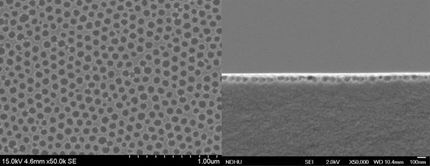Microscopy Today Innovation Award for novel X-ray lenses
High numerical aperture and sharp focus enable record resolution microscopy
For a novel X-ray lens with unprecedented properties, a research team headed by DESY group leader Saša Bajt has been awarded the 'microscopy Today Innovation Award' by the magazine Microscopy Today. The team's “High numerical aperture, high efficiency X-ray lenses” were judged as one of the ten best microscopy innovations in the 2018 competition, and the prize was awarded on Wednesday during the Microscopy & Microanalysis 2018 meeting in Baltimore (USA). Microscopy Today is the official magazine of the Microscopy Society of America (MSA). Team members are Saša Bajt (DESY), Andrzej Andrejczuk (University of Bialystok, Poland), Sabrina Bolmer (DESY), Henry Chapman (DESY and University of Hamburg), Andrew Morgan (DESY), and Mauro Prasciolu (DESY).
The penetrating nature of hard X-rays and their short wavelengths below about 0.1 nanometres (millionths of a millimetre) make them attractive for imaging of objects such as biological cells at resolutions beyond that of visible light and without sectioning or thinning the sample as needed for transmission electron microscopy. However, these properties of X-rays also make them difficult to focus. One way is to use specialised X-ray optics called multilayer Laue lenses (MLLs). These lenses consist of alternating layers of two different materials with nanometre thickness. In contrast to conventional optics, MLLs do not refract light but work by diffracting the incident X-rays in a way that concentrates the beam on a small spot. To achieve this, the layer thickness of the materials has to be precisely controlled. The layers must gradually change in thickness and orientation throughout the lens.
The scientists made several innovations in the fabrication process to achieve high efficiency and to extend the numerical aperture (NA) far beyond what was previously possible, to enable imaging at spatial resolutions below 10 nanometres, with diffraction efficiencies exceeding 80 per cent. The new lenses consist of over 10000 alternating layers of a new material combination, tungsten carbide and silicon carbide. To focus an X-ray beam in the vertical and horizontal directions it has to pass through two perpendicularly oriented lenses. By using this set-up, a spot size of 8.4 nanometres by 6.8 nanometres was demonstrated. The resolution of the new lenses is about five times better than achievable with typical state-of-the-art lenses.
Most read news
Organizations
Other news from the department science

Get the chemical industry in your inbox
From now on, don't miss a thing: Our newsletter for the chemical industry, analytics, lab technology and process engineering brings you up to date every Tuesday and Thursday. The latest industry news, product highlights and innovations - compact and easy to understand in your inbox. Researched by us so you don't have to.




























































